Review of Visualization Technique and Its Application of Road Aggregates Based on Morphological Features
Abstract
1. Introduction
2. Morphological Characteristic Evaluation
2.1. Shape
2.2. Angularity
2.3. Texture
3. Digital Image Acquisition, Processing and Modelling Reconstruction
3.1. Digital Image Acquisition Devices
3.2. Digital Image Processing Analysis
3.3. Digital Modelling Reconstruction Technology
4. Numerical Simulations and Modeling Based on Visualization Techniques
4.1. Idealized Aggregate Model
4.2. Realistic Aggregate Model
4.3. Numerical Methods
5. Applications and Outlook
5.1. Aggregate Void Ratio and Gradation Design
5.2. Compaction Method of Aggregate Specimens
5.3. Mechanical Properties and Dimensional Effects of Aggregates
6. Summary and Recommendations
Author Contributions
Funding
Data Availability Statement
Conflicts of Interest
References
- Zhang, J.; Li, C.; Ding, L.; Li, J. Performance evaluation of cement stabilized recycled mixture with recycled concrete aggregate and crushed brick. Constr. Build. Mater. 2021, 296, 123596. [Google Scholar] [CrossRef]
- Sun, Z.; Li, S.; Zhang, J.; Zeng, Y. Adhesion of Bituminous Crack Sealants to Aggregates Using Surface Energy Theory. J. Mater. Civ. Eng. 2020, 32, 04020299. [Google Scholar] [CrossRef]
- Ren, J.L.; Xu, Y.S.; Huang, J.D.; Wang, Y.; Jia, Z.R. Gradation optimization and strength mechanism of aggregate structure considering macroscopic and mesoscopic aggregate mechanical behaviour in porous asphalt mixture. Constr. Build. Mater. 2021, 300, 124262. [Google Scholar] [CrossRef]
- Shigang, A.; Liqun, T.; Yiqi, M.; Yongmao, P.; Yiping, L.; Daining, F. Effect of aggregate distribution and shape on failure behavior of polyurethane polymer concrete under tension. Comput. Mater. Sci. 2013, 67, 133–139. [Google Scholar] [CrossRef]
- Zhang, D.; Hou, S.; Bian, J.; He, L. Investigation of the micro-cracking behavior of asphalt mixtures in the indirect tensile test. Eng. Fract. Mech. 2016, 163, 416–425. [Google Scholar] [CrossRef]
- Caro, S.; Masad, E.; Bhasin, A.; Little, D. Coupled micromechanical model of moisture-induced damage in asphalt mixtures. J. Mater. Civ. Eng. 2010, 22, 380–388. [Google Scholar] [CrossRef]
- Cannone Falchetto, A.; Moon, K.H.; Wistuba, M.P. Microstructural analysis and rheological modeling of asphalt mixtures containing recycled asphalt materials. Materials 2014, 7, 6254–6280. [Google Scholar] [CrossRef] [PubMed]
- Ng, K.; Dai, Q. Numerical investigation of internal frost damage of digital cement paste samples with cohesive zone modeling and SEM microstructure characterization. Constr. Build. Mater. 2014, 50, 266–275. [Google Scholar] [CrossRef]
- Underwood, B.S.; Kim, Y.R. A four phase micro-mechanical model for asphalt mastic modulus. Mech. Mater. 2014, 75, 13–33. [Google Scholar] [CrossRef]
- Sadd, M.H.; Dai, Q. A comparison of micro-mechanical modeling of asphalt materials using finite elements and doublet mechanics. Mech. Mater. 2005, 37, 641–662. [Google Scholar] [CrossRef]
- Al-Rub, R.K.A.; Darabi, M.K.; Little, D.N.; Masad, E.A. A micro-damage healing model that improves prediction of fatigue life in asphalt mixes. Int. J. Eng. Sci. 2010, 48, 966–990. [Google Scholar] [CrossRef]
- Buttlar, W.G.; You, Z. Discrete element modeling of asphalt concrete: Microfabric approach. Transp. Res. Rec. 2001, 1757, 111–118. [Google Scholar] [CrossRef]
- Kennedy, T.W.; Huber, G.A.; Harrigan, E.T.; Cominsky, R.J.; Hughes, C.S.; Von Quintus, H.; Moulthrop, J.S. Superior Performing Asphalt Pavements (Superpave): The Product of the SHRP Asphalt Research Program; American Association of State Highway and Transportation Officials: Washington, DC, USA, 1994. [Google Scholar]
- Zhang, J.; Li, J.; Yao, Y.; Zheng, J.; Gu, F. Geometric anisotropy modeling and shear behavior evaluation of graded crushed rocks. Constr. Build. Mater. 2018, 183, 346–355. [Google Scholar] [CrossRef]
- Yang, X.; Chen, S.; You, Z. 3D voxel-based approach to quantify aggregate angularity and surface texture. J. Mater. Civ. Eng. 2017, 29, 04017031. [Google Scholar] [CrossRef]
- Zhang, S.; Li, R.; Pei, J. Evaluation methods and indexes of morphological characteristics of coarse aggregates for road materials: A comprehensive review. J. Traffic Transp. Eng. (Engl. Ed.) 2019, 6, 256–272. [Google Scholar] [CrossRef]
- Li, J.; Zhang, J.; Qian, G.; Zheng, J.; Zhang, Y. Three-dimensional simulation of aggregate and asphalt mixture using parameterized shape and size gradation. J. Mater. Civ. Eng. 2019, 31, 04019004. [Google Scholar] [CrossRef]
- Masad, E.; Olcott, D.; White, T.; Tashman, L. Correlation of fine aggregate imaging shape indices with asphalt mixture performance. Transp. Res. Rec. 2001, 1757, 148–156. [Google Scholar] [CrossRef]
- Jun, Y.; Ye, Q. Morphological character of coarse aggregate and its influence on high-temperature shear strength of asphalt mixture. J. Traffic Transp. Eng. 2011, 11, 17–22. [Google Scholar]
- Xiong, Q.; Wang, X.; Zhang, L. Research summary of digital image processing technology on coarse aggregate morphology characteristics. Subgrade Eng. 2012, 1, 7–10. [Google Scholar]
- Wang, H.; Wang, D.; Liu, P.; Hu, J.; Schulze, C.; Oeser, M. Development of morphological properties of road surfacing aggregates during the polishing process. Int. J. Pavement Eng. 2017, 18, 367–380. [Google Scholar] [CrossRef]
- Singh, D.; Zaman, M.; Commuri, S. Comparison of shape parameters for selected coarse aggregates in Oklahoma. J. Test. Eval. 2012, 40, 409–426. [Google Scholar] [CrossRef]
- Wang, L.; Lane, D.S.; Lu, Y.; Druta, C. Portable image analysis system for characterizing aggregate morphology. Transp. Res. Rec. 2009, 2104, 3–11. [Google Scholar] [CrossRef]
- Al Rousan, T.M. Characterization of Aggregate Shape Properties Using a Computer Automated System; Texas A&M University: College Station, TX, USA, 2004. [Google Scholar]
- Wang, A.; Zhang, Z.; Liu, K.; Xu, H.; Shi, L.; Sun, D. Coral aggregate concrete: Numerical description of physical, chemical and morphological properties of coral aggregate. Cem. Concr. Compos. 2019, 100, 25–34. [Google Scholar]
- Miao, Y.; Yu, W.; Wu, J.; Wang, S.; Wang, L. Feasibility of one side 3-D scanning for characterizing aggregate shape. Int. J. Pavement Res. Technol. 2019, 12, 197–205. [Google Scholar] [CrossRef]
- Lucas Júnior, J.L.; Babadopulos, L.F.; Soares, J.B. Effect of aggregate shape properties and binder’s adhesiveness to aggregate on results of compression and tension/compression tests on hot mix asphalt. Mater. Struct. 2020, 53, 43. [Google Scholar] [CrossRef]
- Mora, C.; Kwan, A. Sphericity, shape factor, and convexity measurement of coarse aggregate for concrete using digital image processing. Cem. Concr. Res. 2000, 30, 351–358. [Google Scholar] [CrossRef]
- Al-Rousan, T.; Masad, E.; Tutumluer, E.; Pan, T. Evaluation of image analysis techniques for quantifying aggregate shape characteristics. Constr. Build. Mater. 2007, 21, 978–990. [Google Scholar] [CrossRef]
- Komba, J.J.; Anochie-Boateng, J.K.; van der Merwe Steyn, W. Analytical and laser scanning techniques to determine shape properties of aggregates. Transp. Res. Rec. 2013, 2335, 60–71. [Google Scholar] [CrossRef]
- Anochie-Boateng, J.K.; Komba, J.J.; Mvelase, G.M. Three-dimensional laser scanning technique to quantify aggregate and ballast shape properties. Constr. Build. Mater. 2013, 43, 389–398. [Google Scholar] [CrossRef]
- Pan, T.; Tutumluer, E. Imaging-based direct measurement of aggregate surface area and its application in asphalt mixture design. Int. J. Pavement Eng. 2010, 11, 415–428. [Google Scholar] [CrossRef]
- Tutumluer, E.; Huang, H.; Hashash, Y.; Ghaboussi, J. Discrete element modeling of railroad ballast settlement. In Proceedings of the AREMA Annual Conference, Chicago, IL, USA, 9–12 September 2007. [Google Scholar]
- Ge, H.; Sha, A.; Han, Z.; Xiong, X. Three-dimensional characterization of morphology and abrasion decay laws for coarse aggregates. Constr. Build. Mater. 2018, 188, 58–67. [Google Scholar] [CrossRef]
- Wadell, H. Sphericity and roundness of rock particles. J. Geol. 1933, 41, 310–331. [Google Scholar] [CrossRef]
- Mandelbrot, B.B.; Mandelbrot, B.B. The Fractal Geometry of Nature; WH Freeman: New York, NY, USA, 1982; Volume 1. [Google Scholar]
- Lee, C.; Kramer, T.A. Prediction of three-dimensional fractal dimensions using the two-dimensional properties of fractal aggregates. Adv. Colloid Interface Sci. 2004, 112, 49–57. [Google Scholar] [CrossRef] [PubMed]
- Wang, L.; Wang, X.; Mohammad, L.; Abadie, C. Unified method to quantify aggregate shape angularity and texture using Fourier analysis. J. Mater. Civ. Eng. 2005, 17, 498–504. [Google Scholar] [CrossRef]
- Zhang, D.; Huang, X.; Zhao, Y. Investigation of the shape, size, angularity and surface texture properties of coarse aggregates. Constr. Build. Mater. 2012, 34, 330–336. [Google Scholar] [CrossRef]
- Rajan, B.; Singh, D. Understanding influence of crushers on shape characteristics of fine aggregates based on digital image and conventional techniques. Constr. Build. Mater. 2017, 150, 833–843. [Google Scholar] [CrossRef]
- Sun, W.; Wang, L.; Tutumluer, E. Image analysis technique for aggregate morphology analysis with two-dimensional Fourier transform method. Transp. Res. Rec. 2012, 2267, 3–13. [Google Scholar] [CrossRef]
- Moaveni, M.; Mahmoud, E.; Ortiz, E.M.; Tutumluer, E.; Beshears, S. Use of advanced aggregate imaging systems to evaluate aggregate resistance to breakage, abrasion, and polishing. Transp. Res. Rec. 2014, 2401, 1–10. [Google Scholar] [CrossRef]
- Wang, H.; Wang, C.; Bu, Y.; You, Z.; Yang, X.; Oeser, M. Correlate aggregate angularity characteristics to the skid resistance of asphalt pavement based on image analysis technology. Constr. Build. Mater. 2020, 242, 118150. [Google Scholar] [CrossRef]
- Kuo, C.Y.; Freeman, R.B. Imaging indices for quantification of shape, angularity, and surface texture of aggregates. Transp. Res. Rec. 2000, 1721, 57–65. [Google Scholar] [CrossRef]
- Isa, N.A.M.; Sani, Z.M.; Al-Batah, M.S. Automated Intelligent real-time system for aggregate classification. Int. J. Miner. Process. 2011, 100, 41–50. [Google Scholar] [CrossRef]
- Kuang, D.; Wang, X.; Jiao, Y.; Zhang, B.; Liu, Y.; Chen, H. Influence of angularity and roughness of coarse aggregates on asphalt mixture performance. Constr. Build. Mater. 2019, 200, 681–686. [Google Scholar] [CrossRef]
- Liu, P.; Hu, J.; Wang, D.; Oeser, M.; Alber, S.; Ressel, W.; Falla, G.C. Modelling and evaluation of aggregate morphology on asphalt compression behavior. Constr. Build. Mater. 2017, 133, 196–208. [Google Scholar] [CrossRef]
- Zhu, X.; Qian, G.; Yu, H.; Yao, D.; Shi, C.; Zhang, C. Evaluation of coarse aggregate movement and contact unbalanced force during asphalt mixture compaction process based on discrete element method. Constr. Build. Mater. 2022, 328, 127004. [Google Scholar] [CrossRef]
- Huang, B.; Chen, X.; Shu, X.; Masad, E.; Mahmoud, E. Effects of coarse aggregate angularity and asphalt binder on laboratory-measured permanent deformation properties of HMA. Int. J. Pavement Eng. 2009, 10, 19–28. [Google Scholar] [CrossRef]
- Miller, T.; Swiertz, D.; Tashman, L.; Tabatabaee, N.; Bahia, H.U. Characterization of asphalt pavement surface texture. Transp. Res. Rec. 2012, 2295, 19–26. [Google Scholar] [CrossRef]
- Al-Assi, M.; Kassem, E.; Nielsen, R. Using Close-Range Photogrammetry to Measure Pavement Texture Characteristics and Predict Pavement Friction. Transp. Res. Rec. 2020, 2674, 794–805. [Google Scholar] [CrossRef]
- Khasawneh, M.A.; Shbeeb, N.I.; Al-Omari, A.A. Analytical tool to shorten polishing time based on mean texture depth (MTD) of flexible pavements. Road Mater. Pavement Des. 2020, 21, 737–756. [Google Scholar] [CrossRef]
- Du, Y.; Weng, Z.; Li, F.; Ablat, G.; Wu, D.; Liu, C. A novel approach for pavement texture characterisation using 2D-wavelet decomposition. Int. J. Pavement Eng. 2022, 23, 1851–1866. [Google Scholar] [CrossRef]
- Hu, L.; Yun, D.; Liu, Z.; Du, S.; Zhang, Z.; Bao, Y. Effect of three-dimensional macrotexture characteristics on dynamic frictional coefficient of asphalt pavement surface. Constr. Build. Mater. 2016, 126, 720–729. [Google Scholar] [CrossRef]
- Cui, P.; Xiao, Y.; Yan, B.; Li, M.; Wu, S. Morphological characteristics of aggregates and their influence on the performance of asphalt mixture. Constr. Build. Mater. 2018, 186, 303–312. [Google Scholar] [CrossRef]
- Pan, T.; Tutumluer, E. Evaluation of visual based aggregate shape classifications using the University of Illinois Aggregate Image Analyzer (UIAIA). In Pavement Mechanics and Performance; American Society of Civil Engineers: Reston, VA, USA, 2006; pp. 203–211. [Google Scholar]
- Singh, D.; Zaman, M.; Commuri, S. Inclusion of aggregate angularity, texture, and form in estimating dynamic modulus of asphalt mixes. Road Mater. Pavement Des. 2012, 13, 327–344. [Google Scholar] [CrossRef]
- Kutay, M.E.; Ozturk, H.I.; Abbas, A.R.; Hu, C. Comparison of 2D and 3D image-based aggregate morphological indices. Int. J. Pavement Eng. 2011, 12, 421–431. [Google Scholar] [CrossRef]
- Chen, J.S.; Hsieh, W.; Liao, M.C. Effect of Coarse Aggregate Shape on Engineering Properties of Stone Mastic Asphalt Applied to Airport Pavements. Int. J. Pavement Res. Technol. 2013, 6, 595–601. [Google Scholar]
- Fletcher, T.; Chandan, C.; Masad, E.; Sivakumar, K. Measurement of aggregate texture and its influence on hot mix asphalt (HMA) permanent deformation. J. Test. Eval. 2002, 30, 524–531. [Google Scholar]
- Maerz, N.H. Technical and computational aspects of the measurement of aggregate shape by digital image analysis. J. Comput. Civ. Eng. 2004, 18, 10–18. [Google Scholar] [CrossRef]
- Bessa, I.S.; Branco, V.T.C.; Soares, J.B.; Neto, J.A.N. Aggregate shape properties and their influence on the behavior of hot-mix asphalt. J. Mater. Civ. Eng. 2015, 27, 04014212. [Google Scholar] [CrossRef]
- Zhang, J.; Ding, L.; Li, F.; Peng, J. Recycled aggregates from construction and demolition wastes as alternative filling materials for highway subgrades in China. J. Clean. Prod. 2020, 255, 120223. [Google Scholar] [CrossRef]
- Aragão, F.T.S.; Pazos, A.R.G.; da Motta, L.M.G.; Kim, Y.R.; do Nascimento, L.A.H. Effects of morphological characteristics of aggregate particles on the mechanical behavior of bituminous paving mixtures. Constr. Build. Mater. 2016, 123, 444–453. [Google Scholar] [CrossRef]
- Wang, H.; Bu, Y.; Wang, Y.; Yang, X.; You, Z. The effect of morphological characteristic of coarse aggregates measured with fractal dimension on asphalt mixture’s high-temperature performance. Adv. Mater. Sci. Eng. 2016, 2016, 6264317. [Google Scholar] [CrossRef]
- Puzzo, L.; Loprencipe, G.; Tozzo, C.; D’Andrea, A. Three-dimensional survey method of pavement texture using photographic equipment. Measurement 2017, 111, 146–157. [Google Scholar] [CrossRef]
- Grenfell, J.; Ahmad, N.; Liu, Y.; Apeagyei, A.; Large, D.; Airey, G. Assessing asphalt mixture moisture susceptibility through intrinsic adhesion, bitumen stripping and mechanical damage. Road Mater. Pavement Des. 2014, 15, 131–152. [Google Scholar] [CrossRef]
- Cui, P.; Wu, S.; Xiao, Y.; Wang, F.; Wang, F. Quantitative evaluation of active based adhesion in Aggregate-Asphalt by digital image analysis. J. Adhes. Sci. Technol. 2019, 33, 1544–1557. [Google Scholar] [CrossRef]
- Kutay, M.E.; Arambula, E.; Gibson, N.; Youtcheff, J. Three-dimensional image processing methods to identify and characterise aggregates in compacted asphalt mixtures. Int. J. Pavement Eng. 2010, 11, 511–528. [Google Scholar] [CrossRef]
- Shi, L.; Wang, D.; Jin, C.; Li, B.; Liang, H. Measurement of coarse aggregates movement characteristics within asphalt mixture using digital image processing methods. Measurement 2020, 163, 107948. [Google Scholar] [CrossRef]
- Salemi, M.; Wang, H. Image-aided random aggregate packing for computational modeling of asphalt concrete microstructure. Constr. Build. Mater. 2018, 177, 467–476. [Google Scholar] [CrossRef]
- Barksdale, R.D.; Kemp, M.A.; Sheffield, W.J.; Hubbard, J.L. Measurement of aggregate shape, surface area, and roughness. Transp. Res. Rec. 1991, 1301, 107–116. [Google Scholar]
- Wang, D.; Wang, H.; Bu, Y.; Schulze, C.; Oeser, M. Evaluation of aggregate resistance to wear with Micro-Deval test in combination with aggregate imaging techniques. Wear 2015, 338, 288–296. [Google Scholar] [CrossRef]
- Gong, F.; Liu, Y.; You, Z.; Zhou, X. Characterization and evaluation of morphological features for aggregate in asphalt mixture: A review. Constr. Build. Mater. 2021, 273, 121989. [Google Scholar] [CrossRef]
- Mangulkar, M.; Jamkar, S. Review of particle packing theories used for concrete mix proportioning. Contrib. Pap. 2013, 141, 1324–1331. [Google Scholar]
- Sun, W. Quantification of Morphological Characteristics of Aggregates at Multiple Scales. Ph.D. Thesis, Virginia Tech, Blacksburg, VA, USA, 2015. [Google Scholar]
- Maerz, N.H.; Palangio, T.C.; Franklin, J.A. WipFrag image based granulometry system. In Measurement of Blast Fragmentation; Routledge: London, UK, 2018; pp. 91–99. [Google Scholar]
- Moaveni, M.; Cetin, S.; Brand, A.S.; Dahal, S.; Roesler, J.R.; Tutumluer, E. Machine vision based characterization of particle shape and asphalt coating in Reclaimed Asphalt Pavement. Transp. Geotech. 2016, 6, 26–37. [Google Scholar] [CrossRef]
- Araujo, V.M.; Bessa, I.S.; Branco, V.T.C. Measuring skid resistance of hot mix asphalt using the aggregate image measurement system (AIMS). Constr. Build. Mater. 2015, 98, 476–481. [Google Scholar] [CrossRef]
- Liu, Y.; Sun, W.; Nair, H.; Lane, D.S.; Wang, L. Quantification of aggregate morphologic characteristics with the correlation to uncompacted void content of coarse aggregates in Virginia. Constr. Build. Mater. 2016, 124, 645–655. [Google Scholar] [CrossRef]
- Liu, Y.; Gong, F.; You, Z.; Wang, H. Aggregate morphological characterization with 3D optical scanner versus X-ray computed tomography. J. Mater. Civ. Eng. 2018, 30, 04017248. [Google Scholar] [CrossRef]
- Mahmoud, E.; Gates, L.; Masad, E.; Erdoğan, S.; Garboczi, E. Comprehensive evaluation of AIMS texture, angularity, and dimension measurements. J. Mater. Civ. Eng. 2010, 22, 369–379. [Google Scholar] [CrossRef]
- Rezaei, A.; Masad, E. Experimental-based model for predicting the skid resistance of asphalt pavements. Int. J. Pavement Eng. 2013, 14, 24–35. [Google Scholar] [CrossRef]
- Wang, L.; Sun, W.; Tutumluer, E.; Druta, C. Evaluation of aggregate imaging techniques for quantification of morphological characteristics. Transp. Res. Rec. 2013, 2335, 39–49. [Google Scholar] [CrossRef]
- Wang, H.; Wang, C.; You, Z.; Yang, X.; Huang, Z. Characterising the asphalt concrete fracture performance from X-ray CT Imaging and finite element modelling. Int. J. Pavement Eng. 2018, 19, 307–318. [Google Scholar] [CrossRef]
- Jin, C.; Li, S.; Yang, X. Adaptive three-dimensional aggregate shape fitting and mesh optimization for finite-element modeling. J. Comput. Civ. Eng. 2020, 34, 04020020. [Google Scholar] [CrossRef]
- Jin, C.; Zou, F.; Yang, X.; Liu, K. 3-D virtual design and microstructural modeling of asphalt mixture based on a digital aggregate library. Comput. Struct. 2021, 242, 106378. [Google Scholar] [CrossRef]
- Li, J.; Zhang, J.; Zhang, A.; Peng, J. Evaluation on deformation behavior of granular base material during repeated load triaxial testing by discrete-element method. Int. J. Geomech. 2022, 22, 04022210. [Google Scholar] [CrossRef]
- Sun, P.; Zhang, K.; Han, S.; Xiao, Y. Aggregate Geometrical Features and Their Influence on the Surface Properties of Asphalt Pavement. Materials 2022, 15, 3222. [Google Scholar] [CrossRef] [PubMed]
- Wei, H.; Li, J.; Wang, F.; Zheng, J.; Tao, Y.; Zhang, Y. Numerical investigation on fracture evolution of asphalt mixture compared with acoustic emission. Int. J. Pavement Eng. 2022, 23, 3481–3491. [Google Scholar] [CrossRef]
- Prudêncio, L.R., Jr.; Weidmann, D.F.; de Oliveira, A.L.; Damo, G.F. Particle shape analysis of fine aggregate using a simplified digital image processing method. Mag. Concr. Res. 2013, 65, 27–36. [Google Scholar] [CrossRef]
- Airey, G.; Collop, A. Mechanical and structural assessment of laboratory-and field-compacted asphalt mixtures. Int. J. Pavement Eng. 2016, 17, 50–63. [Google Scholar] [CrossRef]
- Cong, L.; Shi, J.; Wang, T.; Yang, F.; Zhu, T. A method to evaluate the segregation of compacted asphalt pavement by processing the images of paved asphalt mixture. Constr. Build. Mater. 2019, 224, 622–629. [Google Scholar] [CrossRef]
- Li, P.; Ding, Z.; Rao, W. Evaluation of deformation properties of asphalt mixture using aggregate slip test. Int. J. Pavement Eng. 2016, 17, 542–549. [Google Scholar] [CrossRef]
- Li, Q.J.; Zhan, Y.; Yang, G.; Wang, K.C. Pavement skid resistance as a function of pavement surface and aggregate texture properties. Int. J. Pavement Eng. 2020, 21, 1159–1169. [Google Scholar] [CrossRef]
- Zhang, K.; Sun, P.; Li, L.; Zhao, Y.; Zhao, Y.; Zhang, Z. A novel evaluation method of aggregate distribution homogeneity for asphalt pavement based on the characteristics of texture structure. Constr. Build. Mater. 2021, 306, 124927. [Google Scholar] [CrossRef]
- Xing, C.; Xu, H.; Tan, Y.; Liu, X.; Ye, Q. Mesostructured property of aggregate disruption in asphalt mixture based on digital image processing method. Constr. Build. Mater. 2019, 200, 781–789. [Google Scholar] [CrossRef]
- Ding, L.; Zhang, J.; Zhou, C.; Han, S.; Du, Q. Particle breakage investigation of construction waste recycled aggregates in subgrade application scenario. Powder Technol. 2022, 404, 117448. [Google Scholar] [CrossRef]
- You, T.; Al-Rub, R.K.A.; Masad, E.A.; Little, D.N. Three-dimensional microstructural modeling of asphalt concrete by use of X-ray computed tomography. Transp. Res. Rec. 2013, 2373, 63–70. [Google Scholar] [CrossRef]
- Tashman, L.; Masad, E.; D’Angelo, J.; Bukowski, J.; Harman, T. X-ray tomography to characterize air void distribution in superpave gyratory compacted specimens. Int. J. Pavement Eng. 2002, 3, 19–28. [Google Scholar] [CrossRef]
- Zhang, C.; Wang, H.; You, Z.; Yang, X. Compaction characteristics of asphalt mixture with different gradation type through Superpave Gyratory Compaction and X-ray CT Scanning. Constr. Build. Mater. 2016, 129, 243–255. [Google Scholar] [CrossRef]
- Hu, J.; Qian, Z.; Liu, Y.; Zhang, M. High-temperature failure in asphalt mixtures using micro-structural investigation and image analysis. Constr. Build. Mater. 2015, 84, 136–145. [Google Scholar] [CrossRef]
- Hu, J.; Qian, Z.; Liu, Y.; Xue, Y. Microstructural characteristics of asphalt concrete with different gradations by X-ray CT. J. Wuhan Univ. Technol.-Mater. Sci. Ed. 2017, 32, 625–632. [Google Scholar] [CrossRef]
- Yang, X.; You, Z.; Wang, Z.; Dai, Q. Review on heterogeneous model reconstruction of stone-based composites in numerical simulation. Constr. Build. Mater. 2016, 117, 229–243. [Google Scholar] [CrossRef]
- Liu, Y.; You, Z. Discrete-element modeling: Impacts of aggregate sphericity, orientation, and angularity on creep stiffness of idealized asphalt mixtures. J. Eng. Mech. 2011, 137, 294–303. [Google Scholar] [CrossRef]
- Tan, L.; Xiao, J.; Singh, A. Finite Element Analysis on the Uniaxial Compressive Behavior of Concrete with Large-Size Recycled Coarse Aggregate. J. Renew. Mater. 2022, 10, 699. [Google Scholar]
- Kurumatani, M.; Terada, K.; Kato, J.; Kyoya, T.; Kashiyama, K. An isotropic damage model based on fracture mechanics for concrete. Eng. Fract. Mech. 2016, 155, 49–66. [Google Scholar] [CrossRef]
- Bencardino, F.; Condello, A.; Ombres, L. Numerical and analytical modeling of concrete beams with steel, FRP and hybrid FRP-steel reinforcements. Compos. Struct. 2016, 140, 53–65. [Google Scholar] [CrossRef]
- Gong, F.; Liu, Y.; Zhou, X.; You, Z. Lab assessment and discrete element modeling of asphalt mixture during compaction with elongated and flat coarse aggregates. Constr. Build. Mater. 2018, 182, 573–579. [Google Scholar] [CrossRef]
- Kutay, M.E.; Varma, S.; Jamrah, A. A micromechanical model to create digital microstructures of asphalt mastics and crumb rubber-modified binders. Int. J. Pavement Eng. 2017, 18, 754–764. [Google Scholar] [CrossRef]
- Liu, Y.; You, Z. Simulation of cyclic loading tests for asphalt mixtures using user defined models within discrete element method. In GeoCongress 2008: Characterization, Monitoring, and Modeling of Geosystems; American Society of Civil Engineers: Reston, VA, USA, 2008; pp. 742–749. [Google Scholar]
- Liu, Y.; You, Z. Visualization and simulation of asphalt concrete with randomly generated three-dimensional models. J. Comput. Civ. Eng. 2009, 23, 340–347. [Google Scholar] [CrossRef]
- Wang, X.; Liang, Z.; Nie, Z.; Gong, J. Stochastic numerical model of stone-based materials with realistic stone-inclusion features. Constr. Build. Mater. 2019, 197, 830–848. [Google Scholar] [CrossRef]
- Harthong, B.; Jérier, J.F.; Dorémus, P.; Imbault, D.; Donzé, F.V. Modeling of high-density compaction of granular materials by the discrete element method. Int. J. Solids Struct. 2009, 46, 3357–3364. [Google Scholar] [CrossRef]
- Liu, Y.; Zhou, X.; You, Z.; Yao, S.; Gong, F.; Wang, H. Discrete element modeling of realistic particle shapes in stone-based mixtures through MATLAB-based imaging process. Constr. Build. Mater. 2017, 143, 169–178. [Google Scholar] [CrossRef]
- Wang, L.; Park, J.Y.; Fu, Y. Representation of real particles for DEM simulation using X-ray tomography. Constr. Build. Mater. 2007, 21, 338–346. [Google Scholar] [CrossRef]
- Latham, J.P.; Munjiza, A.; Garcia, X.; Xiang, J.; Guises, R. Three-dimensional particle shape acquisition and use of shape library for DEM and FEM/DEM simulation. Miner. Eng. 2008, 21, 797–805. [Google Scholar] [CrossRef]
- Jensen, R.P.; Edil, T.B.; Bosscher, P.J.; Plesha, M.E.; Kahla, N.B. Effect of particle shape on interface behavior of DEM-simulated granular materials. Int. J. Geomech. 2001, 1, 1–19. [Google Scholar] [CrossRef]
- Sobolev, K.; Amirjanov, A. The development of a simulation model of the dense packing of large particulate assemblies. Powder Technol. 2004, 141, 155–160. [Google Scholar] [CrossRef]
- Gopalakrishnan, K.; Shashidhar, N. Structural characteristics of three-dimensional random packing of aggregates with wide size distribution. Int. J. Civ. Environ. Eng. 2007, 1, 78–85. [Google Scholar]
- Fu, G.; Dekelbab, W. 3-D random packing of polydisperse particles and concrete aggregate grading. Powder Technol. 2003, 133, 147–155. [Google Scholar] [CrossRef]
- Liu, L.; Shen, D.; Chen, H.; Xu, W. Aggregate shape effect on the diffusivity of mortar: A 3D numerical investigation by random packing models of ellipsoidal particles and of convex polyhedral particles. Comput. Struct. 2014, 144, 40–51. [Google Scholar] [CrossRef]
- He, H.; Guo, Z.; Stroeven, P.; Stroeven, M.; Sluys, L.J. Characterization of the packing of aggregate in concrete by a discrete element approach. Mater. Charact. 2009, 60, 1082–1087. [Google Scholar] [CrossRef]
- Du, C.B.; Sun, L.G. Numerical simulation of aggregate shapes of two-dimensional concrete and its application. J. Aerosp. Eng. 2007, 20, 172–178. [Google Scholar] [CrossRef]
- Ma, H.; Xu, W.; Li, Y. Random aggregate model for mesoscopic structures and mechanical analysis of fully-graded concrete. Comput. Struct. 2016, 177, 103–113. [Google Scholar] [CrossRef]
- Liu, B.; Bai, G.L.; Xu, Z.H.; Ma, J.F.; Han, Y.Y. Experimental study and finite element modeling of bond behavior between recycled aggregate concrete and the shaped steel. Eng. Struct. 2019, 201, 109840. [Google Scholar] [CrossRef]
- Ferellec, J.F.; McDowell, G. A simple method to create complex particle shapes for DEM. Geomech. Geoengin. Int. J. 2008, 3, 211–216. [Google Scholar] [CrossRef]
- Yang, X.; You, Z.; Jin, C.; Wang, H. Aggregate representation for mesostructure of stone based materials using a sphere growth model based on realistic aggregate shapes. Mater. Struct. 2016, 49, 2493–2508. [Google Scholar] [CrossRef]
- Zhou, R.; Song, Z.; Lu, Y. 3D mesoscale finite element modelling of concrete. Comput. Struct. 2017, 192, 96–113. [Google Scholar] [CrossRef]
- Yu, Y.; Zheng, Y.; Guo, Y.; Hu, S.; Hua, K. Mesoscale finite element modeling of recycled aggregate concrete under axial tension. Constr. Build. Mater. 2021, 266, 121002. [Google Scholar] [CrossRef]
- Coleri, E.; Harvey, J.T.; Yang, K.; Boone, J.M. Development of a micromechanical finite element model from computed tomography images for shear modulus simulation of asphalt mixtures. Constr. Build. Mater. 2012, 30, 783–793. [Google Scholar] [CrossRef]
- Souza, L.T.; Kim, Y.R.; Souza, F.V.; Castro, L.S. Experimental testing and finite-element modeling to evaluate the effects of aggregate angularity on bituminous mixture performance. J. Mater. Civ. Eng. 2012, 24, 249–258. [Google Scholar] [CrossRef]
- Shahbeyk, S.; Hosseini, M.; Yaghoobi, M. Mesoscale finite element prediction of concrete failure. Comput. Mater. Sci. 2011, 50, 1973–1990. [Google Scholar] [CrossRef]
- Wang, Z.; Kwan, A.; Chan, H. Mesoscopic study of concrete I: Generation of random aggregate structure and finite element mesh. Comput. Struct. 1999, 70, 533–544. [Google Scholar] [CrossRef]
- Peng, Z.; Doroodchi, E.; Moghtaderi, B. Heat transfer modelling in Discrete Element Method (DEM)-based simulations of thermal processes: Theory and model development. Prog. Energy Combust. Sci. 2020, 79, 100847. [Google Scholar] [CrossRef]
- Zhang, T.; Zhang, C.; Zou, J.; Wang, B.; Song, F.; Yang, W. DEM exploration of the effect of particle shape on particle breakage in granular assemblies. Comput. Geotech. 2020, 122, 103542. [Google Scholar] [CrossRef]
- Wang, X.; Yin, Z.Y.; Su, D.; Wu, X.; Zhao, J. A novel approach of random packing generation of complex-shaped 3D particles with controllable sizes and shapes. Acta Geotech. 2022, 17, 355–376. [Google Scholar] [CrossRef]
- Wang, X.; Nie, Z.; Gong, J.; Liang, Z. Random generation of convex aggregates for DEM study of particle shape effect. Constr. Build. Mater. 2021, 268, 121468. [Google Scholar] [CrossRef]
- Collop, A.C.; McDowell, G.R.; Lee, Y. Use of the distinct element method to model the deformation behavior of an idealized asphalt mixture. Int. J. Pavement Eng. 2004, 5, 1–7. [Google Scholar] [CrossRef]
- Collop, A.C.; McDowell, G.R.; Lee, Y.W. Modelling dilation in an idealised asphalt mixture using discrete element modelling. Granul. Matter 2006, 8, 175–184. [Google Scholar] [CrossRef]
- You, Z.; Adhikari, S.; Dai, Q. Three-dimensional discrete element models for asphalt mixtures. J. Eng. Mech. 2008, 134, 1053–1063. [Google Scholar] [CrossRef]
- Wang, X.; Yin, Z.Y.; Xiong, H.; Su, D.; Feng, Y.T. A spherical-harmonic-based approach to discrete element modeling of 3D irregular particles. Int. J. Numer. Methods Eng. 2021, 122, 5626–5655. [Google Scholar] [CrossRef]
- Dondi, G.; Simone, A.; Vignali, V.; Manganelli, G. Numerical and experimental study of granular mixes for asphalts. Powder Technol. 2012, 232, 31–40. [Google Scholar] [CrossRef]
- Ferellec, J.F.; McDowell, G.R. A method to model realistic particle shape and inertia in DEM. Granul. Matter 2010, 12, 459–467. [Google Scholar] [CrossRef]
- Fu, Y.; Wang, L.; Zhou, C. 3D clustering DEM simulation and non-invasive experimental verification of shear localisation in irregular particle assemblies. Int. J. Pavement Eng. 2010, 11, 355–365. [Google Scholar] [CrossRef]
- He, H.; Stroeven, P.; Pirard, E.; Courard, L. On the shape simulation of aggregate and cement particles in a DEM system. Adv. Mater. Sci. Eng. 2015, 2015, 692768. [Google Scholar] [CrossRef]
- Zhang, D.; Huang, X.; Zhao, Y. Algorithms for generating three-dimensional aggregates and asphalt mixture samples by the discrete-element method. J. Comput. Civ. Eng. 2013, 27, 111–117. [Google Scholar] [CrossRef]
- Yao, Y.; Li, J.; Liang, C.; Hu, X. Effect of coarse recycled aggregate on failure strength for asphalt mixture using experimental and DEM method. Coatings 2021, 11, 1234. [Google Scholar] [CrossRef]
- Yao, Y.; Li, J.; Ni, J.; Liang, C.; Zhang, A. Effects of gravel content and shape on shear behaviour of soil-rock mixture: Experiment and DEM modelling. Comput. Geotech. 2022, 141, 104476. [Google Scholar] [CrossRef]
- Sherzer, G.L.; Alghalandis, Y.F.; Peterson, K. Introducing fracturing through aggregates in LDPM. Eng. Fract. Mech. 2022, 261, 108228. [Google Scholar] [CrossRef]
- Sherzer, G.L.; Alghalandis, Y.F.; Peterson, K.; Shah, S. Comparative study of scale effect in concrete fracturing via Lattice Discrete Particle and Finite Discrete Element Models. Eng. Fail. Anal. 2022, 135, 106062. [Google Scholar] [CrossRef]
- Naderi, S.; Tu, W.; Zhang, M. Meso-scale modelling of compressive fracture in concrete with irregularly shaped aggregates. Cem. Concr. Res. 2021, 140, 106317. [Google Scholar] [CrossRef]
- Xing, C.; Xu, H.; Tan, Y.; Liu, X.; Zhou, C.; Scarpas, T. Gradation measurement of asphalt mixture by X-ray CT images and digital image processing methods. Measurement 2019, 132, 377–386. [Google Scholar] [CrossRef]
- Chen, J.; Huang, B.; Shu, X. Air-void distribution analysis of asphalt mixture using discrete element method. J. Mater. Civ. Eng. 2013, 25, 1375–1385. [Google Scholar] [CrossRef]
- Dubois, V.; De La Roche, C.; Burban, O. Influence of the compaction process on the air void homogeneity of asphalt mixtures samples. Constr. Build. Mater. 2010, 24, 885–897. [Google Scholar] [CrossRef]
- Liu, P.; Hu, J.; Falla, G.C.; Wang, D.; Leischner, S.; Oeser, M. Primary investigation on the relationship between microstructural characteristics and the mechanical performance of asphalt mixtures with different compaction degrees. Constr. Build. Mater. 2019, 223, 784–793. [Google Scholar] [CrossRef]
- Park, S.B.; Seo, D.S.; Lee, J. Studies on the sound absorption characteristics of porous concrete based on the content of recycled aggregate and target void ratio. Cem. Concr. Res. 2005, 35, 1846–1854. [Google Scholar] [CrossRef]
- Aliha, M.; Fattahi Amirdehi, H. Fracture toughness prediction using Weibull statistical method for asphalt mixtures containing different air void contents. Fatigue Fract. Eng. Mater. Struct. 2017, 40, 55–68. [Google Scholar] [CrossRef]
- Golalipour, A.; Jamshidi, E.; Niazi, Y.; Afsharikia, Z.; Khadem, M. Effect of aggregate gradation on rutting of asphalt pavements. Procedia-Soc. Behav. Sci. 2012, 53, 440–449. [Google Scholar] [CrossRef]
- Elliott, R.P.; Ford, M.C., Jr.; Ghanim, M.; Tu, Y.F. Effect of aggregate gradation variation on asphalt concrete mix properties. Transp. Res. Rec. 1991, 1317, 52–60. [Google Scholar]
- Hunter, A.E.; McGreavy, L.; Airey, G.D. Effect of compaction mode on the mechanical performance and variability of asphalt mixtures. J. Transp. Eng. 2009, 135, 839–851. [Google Scholar] [CrossRef]
- Pérez-Jiménez, F.; Martínez, A.H.; Miró, R.; Hernández-Barrera, D.; Araya-Zamorano, L. Effect of compaction temperature and procedure on the design of asphalt mixtures using Marshall and gyratory compactors. Constr. Build. Mater. 2014, 65, 264–269. [Google Scholar] [CrossRef]
- Dan, H.C.; Yang, D.; Zhao, L.H.; Wang, S.P.; Zhang, Z. Meso-scale study on compaction characteristics of asphalt mixtures in Superpave gyratory compaction using SmartRock sensors. Constr. Build. Mater. 2020, 262, 120874. [Google Scholar] [CrossRef]
- Wei, H.; Bai, X.P.; Wang, F.Y.; Li, W.; Jin, J. Mixing ratio design of emulsified asphalt cold recycled mixture based on gyratory compaction molding. J. Cent. South Univ. 2019, 26, 759–767. [Google Scholar]
- Şengün, E.; Alam, B.; Shabani, R.; Yaman, I. The effects of compaction methods and mix parameters on the properties of roller compacted concrete mixtures. Constr. Build. Mater. 2019, 228, 116807. [Google Scholar] [CrossRef]
- Awed, A.; Kassem, E.; Masad, E.; Little, D. Method for predicting the laboratory compaction behavior of asphalt mixtures. J. Mater. Civ. Eng. 2015, 27, 04015016. [Google Scholar] [CrossRef]
- Coenen, A.R.; Kutay, M.E.; Sefidmazgi, N.R.; Bahia, H.U. Aggregate structure characterisation of asphalt mixtures using two-dimensional image analysis. Road Mater. Pavement Des. 2012, 13, 433–454. [Google Scholar] [CrossRef]
- Chang, J.; Li, J.; Hu, H.; Qian, J.; Yu, M. Numerical investigation on aggregate segregation of Superpave gyratory compaction and its influence on mechanical properties of asphalt mixtures. J. Mater. Civ. Eng. 2022, in press. [Google Scholar]
- Hassan, N.A.; Airey, G.D.; Khan, R.; Collop, A.C. Nondestructive characterisation of the effect of asphalt mixture compaction on aggregate orientation and segregation using X-ray computed tomography. Int. J. Pavement Res. Technol. 2012, 5, 84. [Google Scholar]
- Jiang, S.; Shen, L. Aggregate shape effect on fracture and breakage of cementitious granular materials. Int. J. Mech. Sci. 2022, 220, 107161. [Google Scholar] [CrossRef]
- Zhang, J.; Gu, F.; Zhang, Y. Use of building-related construction and demolition wastes in highway embankment: Laboratory and field evaluations. J. Clean. Prod. 2019, 230, 1051–1060. [Google Scholar] [CrossRef]
- Bektas, F.; Wang, K.; Ceylan, H. Effects of crushed clay brick aggregate on mortar durability. Constr. Build. Mater. 2009, 23, 1909–1914. [Google Scholar] [CrossRef]
- Mostofinejad, D.; Reisi, M. A new DEM-based method to predict packing density of coarse aggregates considering their grading and shapes. Constr. Build. Mater. 2012, 35, 414–420. [Google Scholar] [CrossRef]
- Li, J.; Huang, Y.; Pu, H.; Gao, H.; Li, Y.; Ouyang, S.; Guo, Y. Influence of block shape on macroscopic deformation response and meso-fabric evolution of crushed gangue under the triaxial compression. Powder Technol. 2021, 384, 112–124. [Google Scholar] [CrossRef]
- Zhao, L.; Zhang, S.; Huang, D.; Wang, X.; Zhang, Y. 3D shape quantification and random packing simulation of rock aggregates using photogrammetry-based reconstruction and discrete element method. Constr. Build. Mater. 2020, 262, 119986. [Google Scholar] [CrossRef]
- Wu, J.; Zhou, X.; Zeng, X.; Xie, Y.; Long, G.; Dong, R.; Umar, H.A.; Ma, G.; Yao, L. Effect of aggregate morphology characteristics on the voidage of aggregate loose packing based on 3D discrete element method. Constr. Build. Mater. 2022, 348, 128598. [Google Scholar] [CrossRef]
- Rocco, C.; Elices, M. Effect of aggregate shape on the mechanical properties of a simple concrete. Eng. Fract. Mech. 2009, 76, 286–298. [Google Scholar] [CrossRef]
- Jaya, R.P.; Hassan, N.A.; Mahmud, M.Z.H.; Aziz, M.M.A.; Hamzah, M.O.; Wan, C.N.C. Effect of aggregate shape on the properties of asphaltic concrete AC14. J. Teknol. 2014, 71, 69–73. [Google Scholar]
- Sun, Y.; Zhang, Z.; Wei, X.; Du, C.; Gong, M.; Chen, J.; Gong, H. Mesomechanical prediction of viscoelastic behavior of asphalt concrete considering effect of aggregate shape. Constr. Build. Mater. 2021, 274, 122096. [Google Scholar] [CrossRef]
- Sengoz, B.; Onsori, A.; Topal, A. Effect of aggregate shape on the surface properties of flexible pavement. KSCE J. Civ. Eng. 2014, 18, 1364–1371. [Google Scholar] [CrossRef]
- Pouranian, M.R.; Shishehbor, M.; Haddock, J.E. Impact of the coarse aggregate shape parameters on compaction characteristics of asphalt mixtures. Powder Technol. 2020, 363, 369–386. [Google Scholar] [CrossRef]
- Cook, C.S.; Tanyu, B.F.; Yavuz, A.B. Effect of particle shape on durability and performance of unbound aggregate base. J. Mater. Civ. Eng. 2017, 29, 04016221. [Google Scholar] [CrossRef]
- Singh, D.; Zaman, M.; Commuri, S. Effect of production and sample preparation methods on aggregate shape parameters. Int. J. Pavement Eng. 2013, 14, 154–175. [Google Scholar] [CrossRef]
- Ghabchi, R.; Zaman, M.; Kazmee, H.; Singh, D. Effect of shape parameters and gradation on laboratory-measured permeability of aggregate bases. Int. J. Geomech. 2015, 15, 04014070. [Google Scholar] [CrossRef]
- Piotrowska, E.; Malecot, Y.; Ke, Y. Experimental investigation of the effect of coarse aggregate shape and composition on concrete triaxial behavior. Mech. Mater. 2014, 79, 45–57. [Google Scholar] [CrossRef]
- Grigorovitch, M.; Gal, E.; Waisman, H. Embedded unit cell homogenization model for localized non-periodic elasto-plastic zones. Comput. Mech. 2021, 68, 1437–1456. [Google Scholar] [CrossRef]
- Meng, Q.; Wang, H.; Xu, W.; Cai, M. A numerical homogenization study of the elastic property of a soil-rock mixture using random mesostructure generation. Comput. Geotech. 2018, 98, 48–57. [Google Scholar] [CrossRef]
- Meng, Q.-X.; Lv, D.; Liu, Y. Mesoscale computational modeling of concrete-like particle-reinforced composites with non-convex aggregates. Comput. Struct. 2020, 240, 106349. [Google Scholar] [CrossRef]
- Qian, G.; Hu, K.; Li, J.; Bai, X.; Li, N. Compaction process tracking for asphalt mixture using discrete element method. Constr. Build. Mater. 2020, 235, 117478. [Google Scholar] [CrossRef]
- Alam, S.; Loukili, A.; Grondin, F. Monitoring size effect on crack opening in concrete by digital image correlation. Eur. J. Environ. Civ. Eng. 2012, 16, 818–836. [Google Scholar] [CrossRef]
- Jin, L.; Yu, W.; Du, X.; Yang, W. Meso-scale simulations of size effect on concrete dynamic splitting tensile strength: Influence of aggregate content and maximum aggregate size. Eng. Fract. Mech. 2020, 230, 106979. [Google Scholar] [CrossRef]
- Wang, X.-H.; Zhang, S.-R.; Wang, C.; Song, R.; Shang, C.; Fang, X. Experimental investigation of the size effect of layered roller compacted concrete (RCC) under high-strain-rate loading. Constr. Build. Mater. 2018, 165, 45–57. [Google Scholar] [CrossRef]
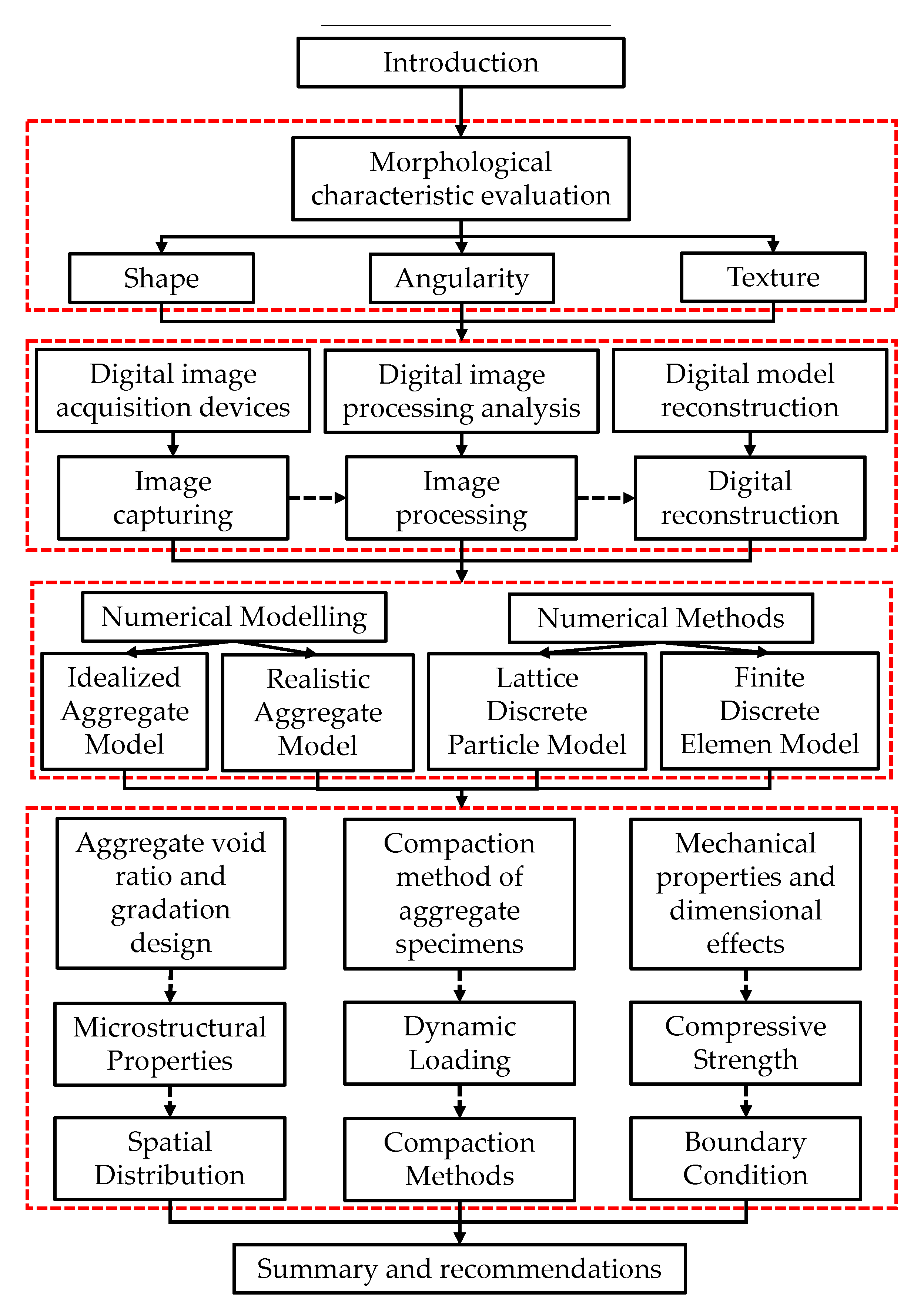
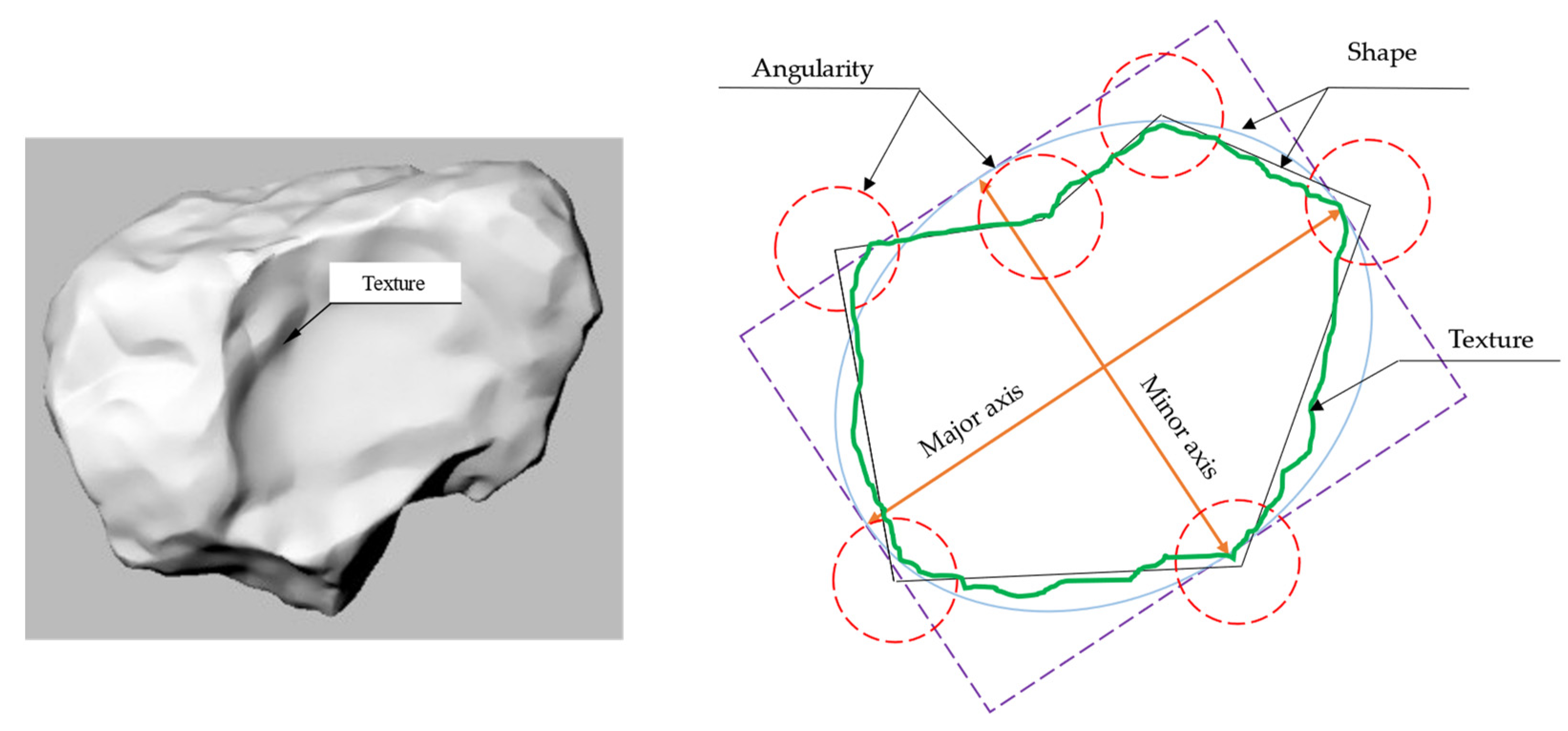
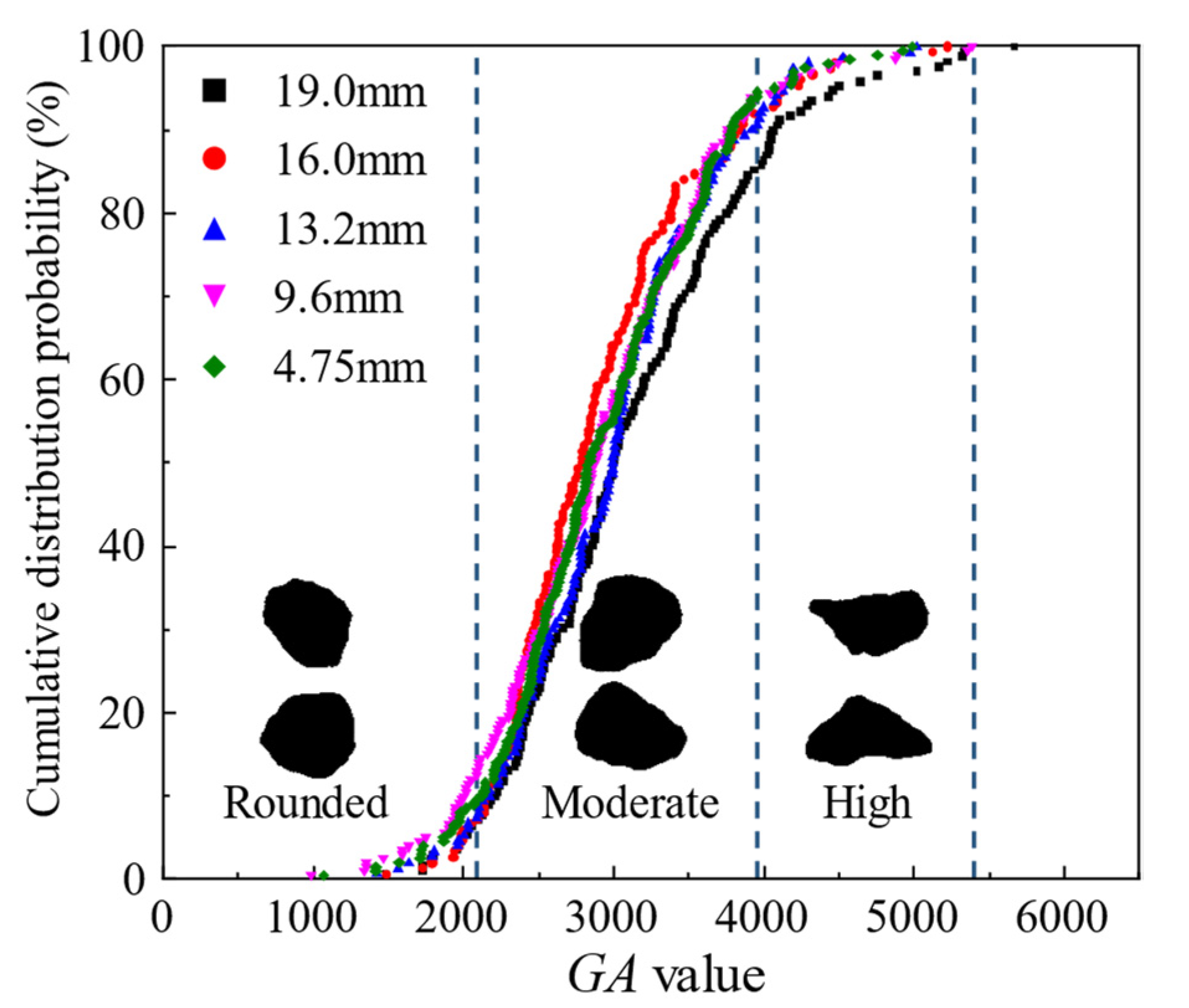
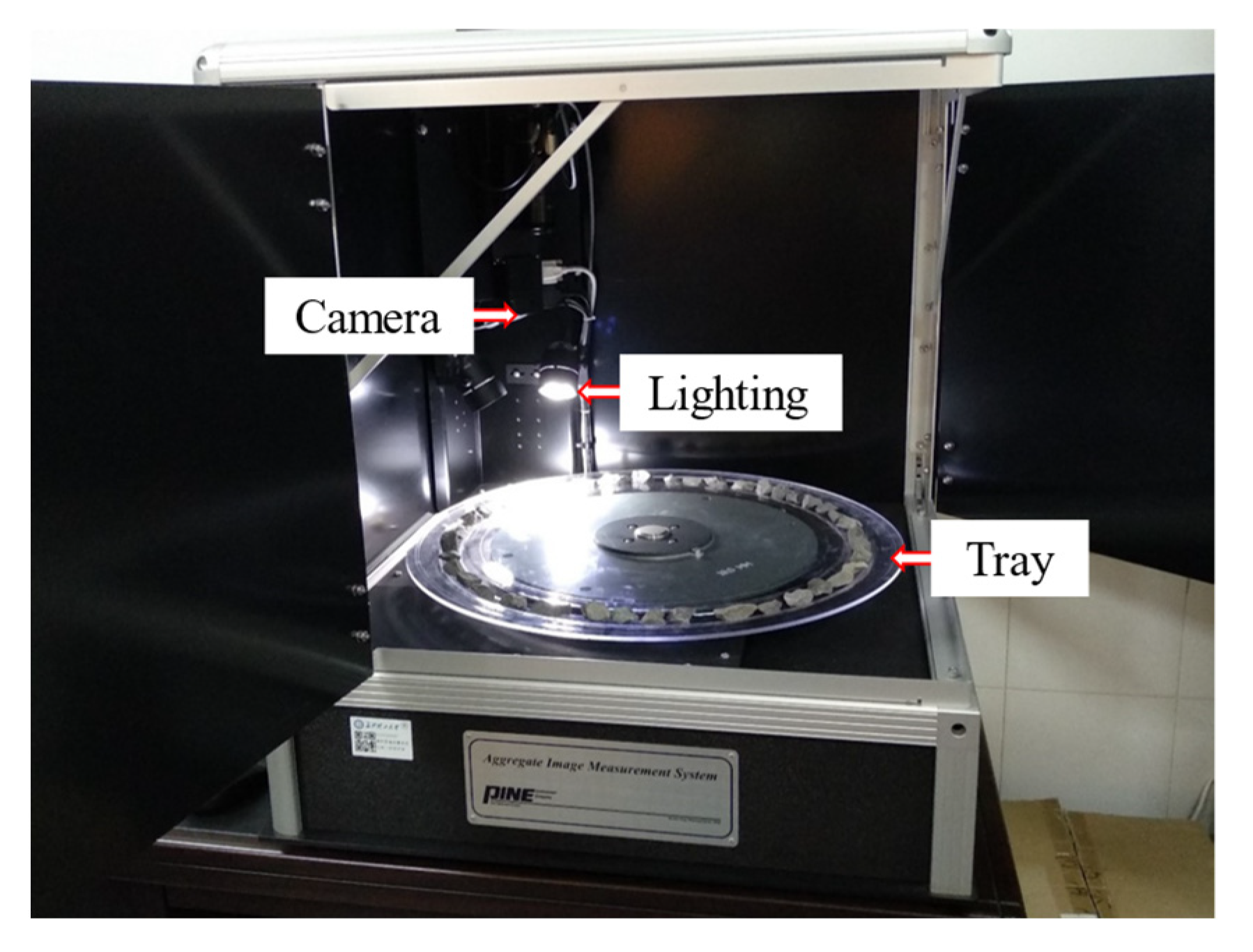
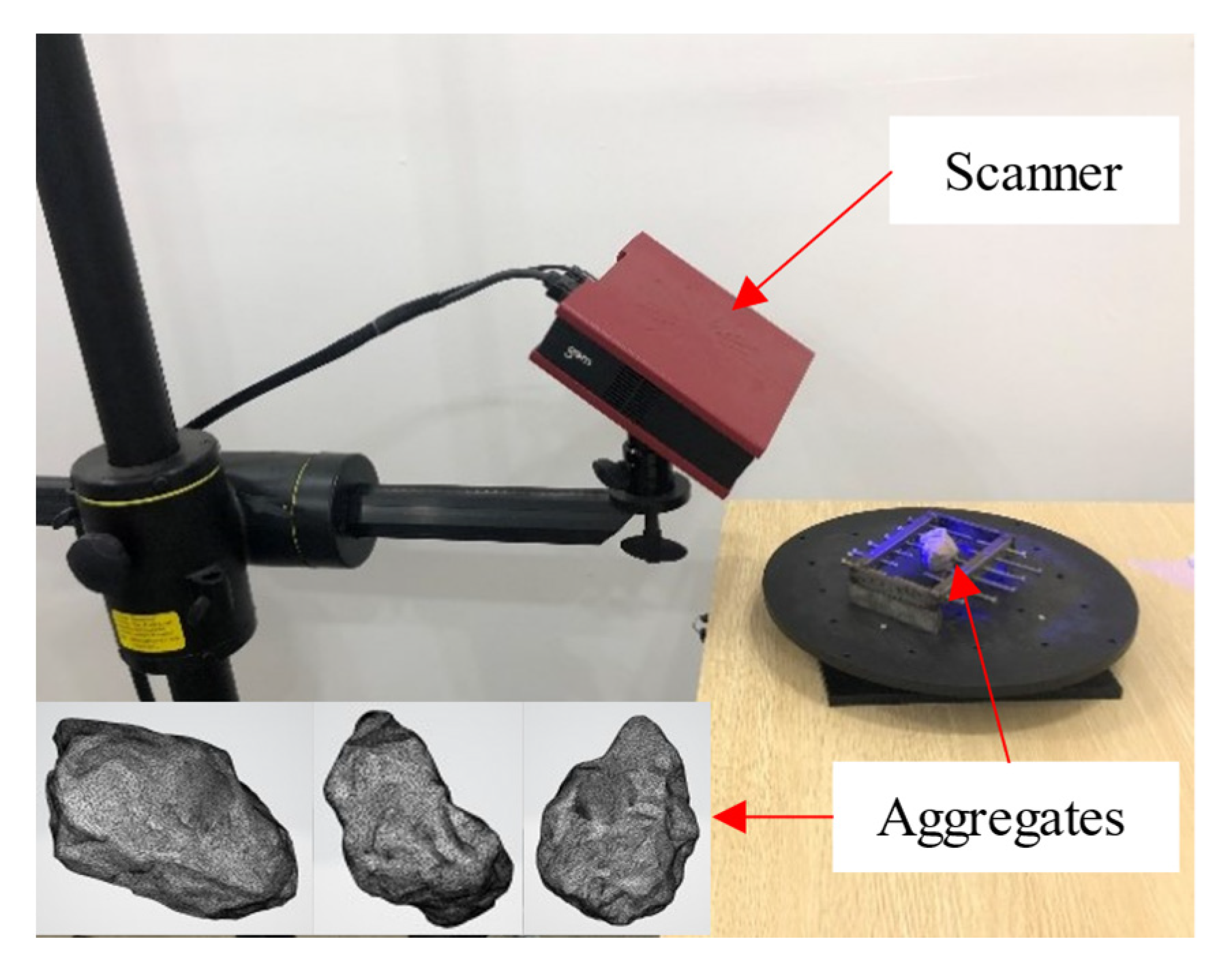


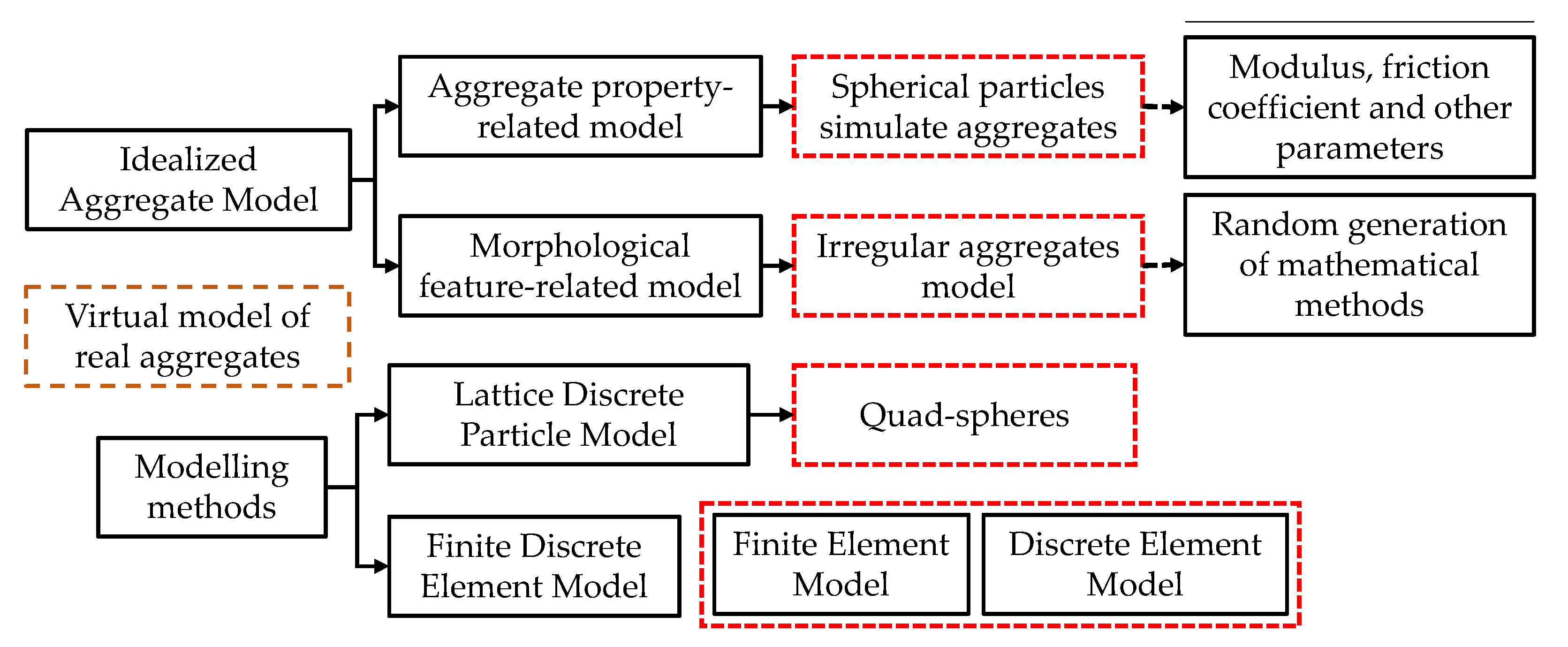
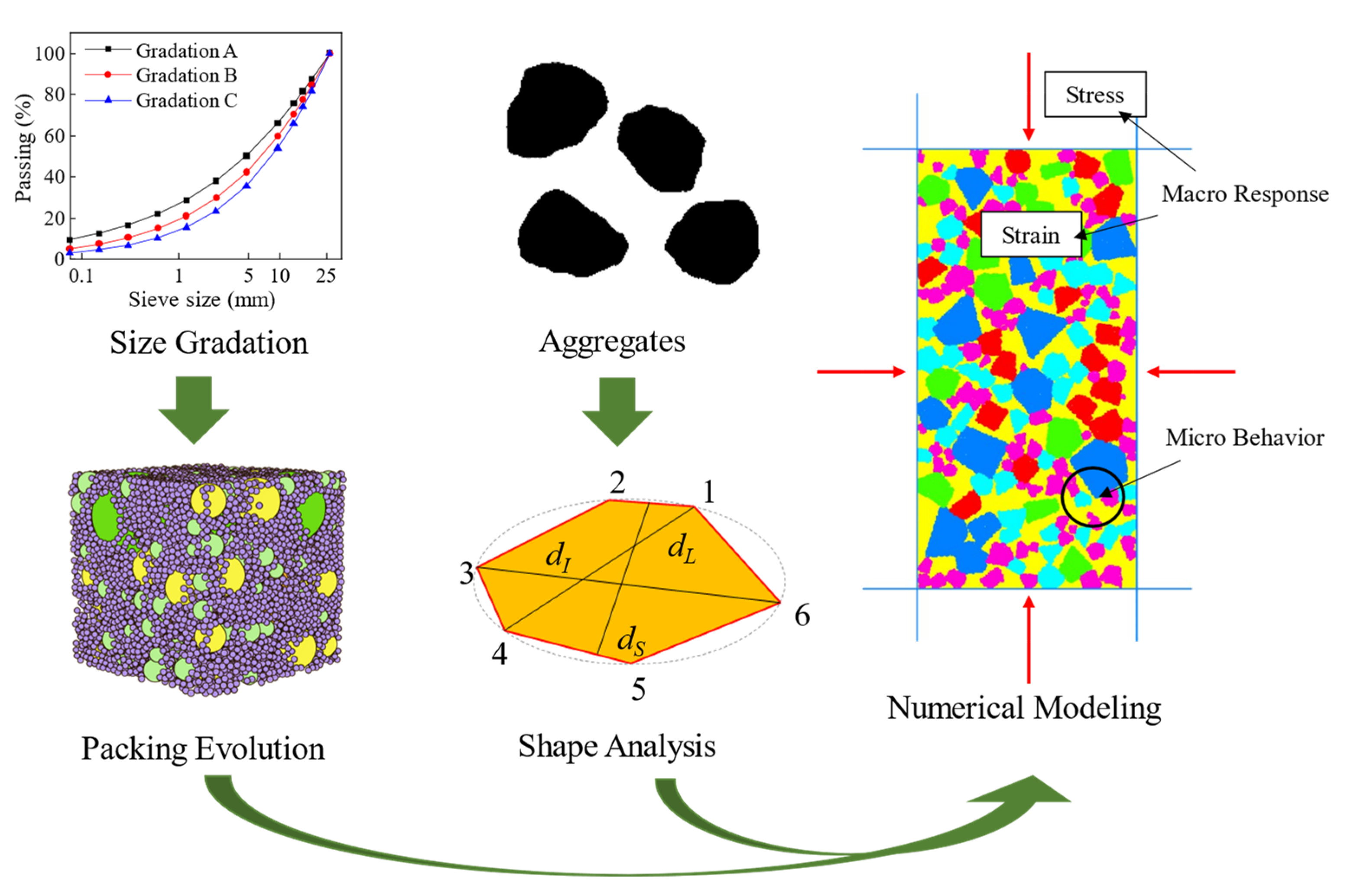

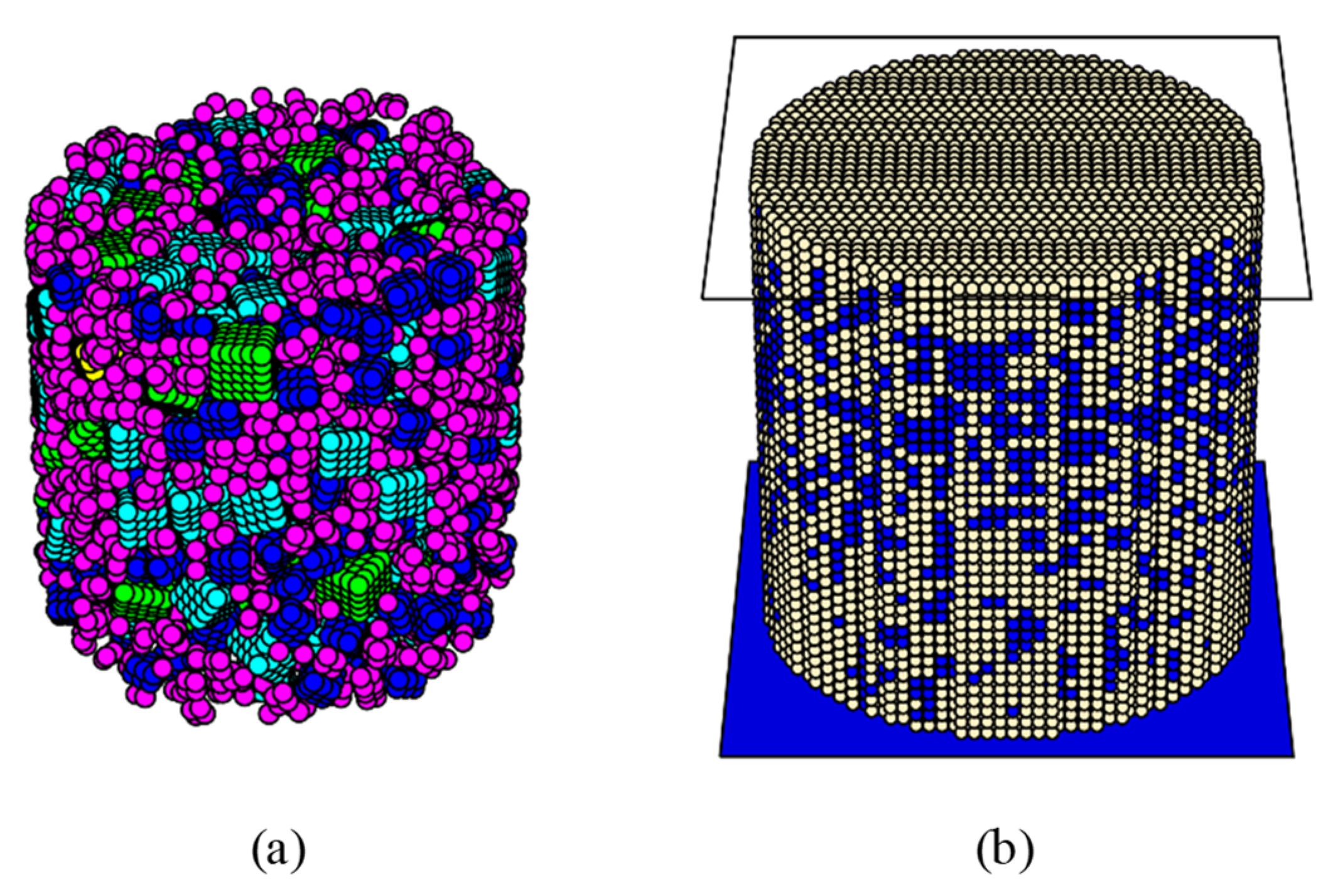

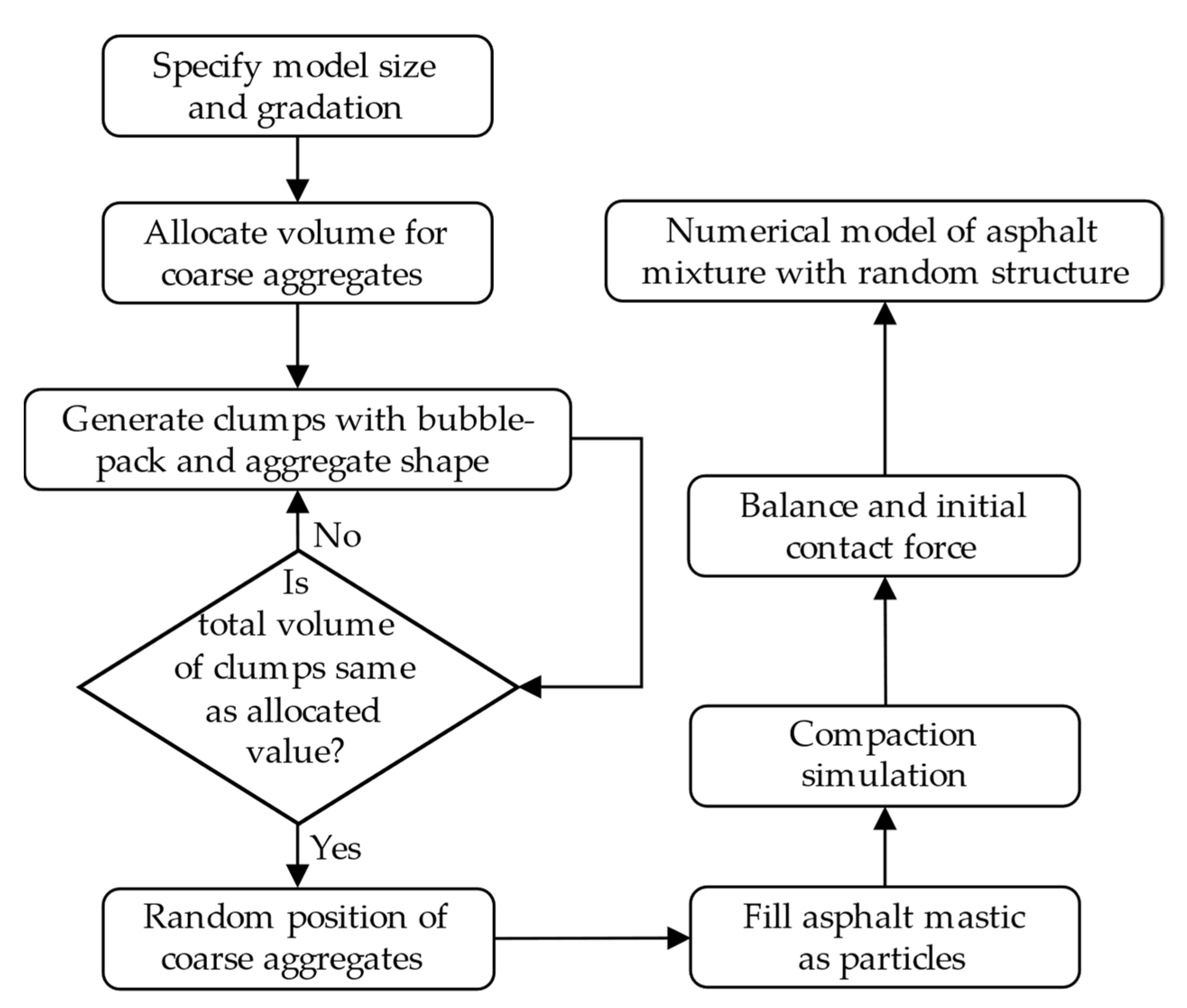

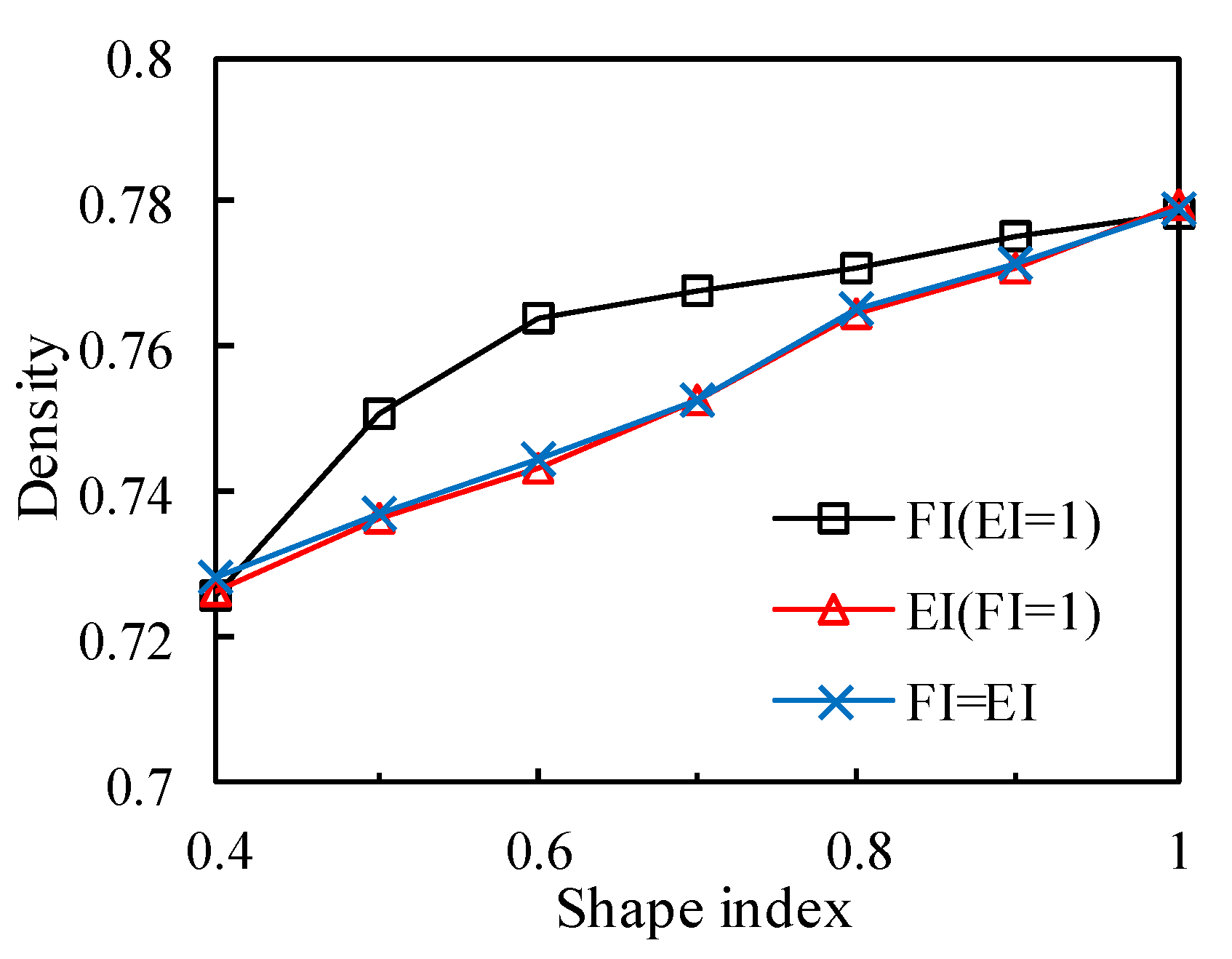

| Shape Indexes | Equations * | Characteristics | Literatures |
|---|---|---|---|
| Form index (2D) | Quantifying the 2D image of fine aggregates of relative form and using incremental changes in the particle radius. | [18] | |
| Aspect ratio (AR) | These parameters use the length and area method to characterize the shape of the aggregate; however, it loses a large amount of shape detail information | [19] | |
| Rectangular degree (RD) | [20] | ||
| Axial coefficient (AC) | [21] | ||
| Eccentricity (E) | Eccentricity could characterize the shape of the aggregate particles and reflect the elliptical oblate degree. | [19] | |
| Roundness | Roundness was the inverse of the form factor. In early imaging techniques, it was used to calculate 2D features of particle shape. | [22] | |
| Form index using Fourier series (FRFORM) | Fourier series can be used to analyze the form, angularity, and texture of aggregate shape. | [23] | |
| Form (shape) index(Fourier series) | [23] | ||
| Ratio of Breadth to Width | Breadth to width ratio can be used to describe the form of aggregate particles. | [24] | |
| Symmetry | Symmetry is a term that some imaging systems use to describe aggregate form. | [24] | |
| Shape Factor (SF) | Shape Factor was a typical index in a system that represented in terms of three dimensions (longest, intermediate, and shortest dimensions). | [25] | |
| Flat and elongated ratio (FER) | FER represents the ratio between the longest dimension and the shortest dimension of a particle. | [26] | |
| Sphericity () | Sphericity is a 3D parameter, which can characterize the aggregate morphology more accurately. | [27] |
| Angularity Indexes | Equations * | Characteristics | Literatures |
|---|---|---|---|
| Angularity | Fourier series analysis was applied to measure the angularity of aggregate in PIAS. | [38] | |
| Angularity factor (AF) | The fast Fourier transform method could be applied to calculate and analyze the angularity factor (AF) of aggregate in FTI. | [41] | |
| Surface erosion-dilation method | As a popular image processing technique, erosion dilation was utilized to analyze the angularity of aggregate particles in the UIAIA. | [42] | |
| Gradient angularity (GA) | Higher values of GA indicate more angular aggregate particles. | [43] | |
| Angularity index (AI) (radius) | As the defining equation of angularity. | [27] | |
| 3D angularity (3DA) | 3D parameters for more accurate characterization of aggregate morphology. | [43] | |
| Angularity parameter | All of them optimize the profile of the particles of the aggregate but cannot retain the original morphological characteristics of the aggregate. | [44] | |
| Convexity | [45] | ||
| Average angularitycoefficient | [46] |
| Texture Indexes | Equations * | Characteristics | Literatures |
|---|---|---|---|
| Texture factor (TF) | Fast measurement of aggregated morphological features based on 2D fast Fourier transform. | [55] | |
| Texture index (TI) | Quantization of textures using wavelet methods. | [55] | |
| Erosion dilation area ratio (EDR) | Changes in area after erosion and dilatation cycles are directly related to aggregate texture. | [56] | |
| Comprehensive erosion dilation area ratio (CEDR) | Aggregate gradation is considered. | [57] | |
| Surface texture | The shape, angularity and texture of the aggregates are considered separately. | [38] | |
| Fourier series analysis method | Calculation of the surface fabric of aggregates used in PIAS. | [23] | |
| Direct measurement of aggregate dimensions | For evaluating textures, the texture parameters are related to the perimeter. | [44] | |
| Three-dimensional Texture () | 3D textures can be calculated.Can differentiate between aggregates with similar sizes.Used to compare aggregates of different sizes and volumes. | [58] |
| Imaging Techniques | Aggregate Size Range | Morphological Calculation Methods | Literatures | |||
|---|---|---|---|---|---|---|
| Shape | Angularity | Texture | ||||
| Early digital imaging devices | No.8-1-inch | Shape | - | - | [72] | |
| Dynamic imaging techniques | VDG-40 | No.16 to 1.5 inch | Length and width | - | - | [74] |
| CPA | No.140 to 1.5 inch | Gradation and aspect ratio | - | - | [75] | |
| PSDA | No.200 to 1.5 inch | Shape, and gradation | - | - | [76] | |
| VIS | No.16 to 1.5 inch | Shape | - | - | [76] | |
| PSSDA | No.200 to 1.5 inch | Grading | - | - | [76] | |
| Camsizer | No.50 to 0.5 inch | Sphericity and aspect ratio | - | - | [45] | |
| WipShape | No.4 to 1.0 inch | Grading and aspect ratio | Minimum average curve radius method | - | [77] | |
| UIAIA | No.4 to 1.5 inch | Sphericity and aspect ratio | Change of outline slope | Erosion and dilation technique | [78] | |
| Static imaging techniques | LAAS | No.10 to 4.0 inch | Aspect ratio | Wavelet method | [26] | |
| AIMS II | No.200 to l.0 inch | Sphericity and aspect ratio | Gradient method | Wavelet method | [79] | |
| FTI system | No.50 to 0.75 inch | Sphericity and aspect ratio | Two-dimensional Fourier transform method | [80] | ||
| PIAS | No.200 to 1.0 inch | Fast Fourier transform method | [23] | |||
| OSAAS | No.16 to 5.0 inch | Sphericity, aspect ratio, and Spherical Harmonic Series | Wavelet method and Spherical Harmonic Series (SHS) | [81] | ||
| X-ray CT | No.200 to 5.0 inch | Spherical Harmonic Series | [81] | |||
| Imaging Techniques | Camera Setup | Advantages | Disadvantages | |
|---|---|---|---|---|
| Early Imaging method | Digitizer with microcomputer | Measures shape. | No angularity or texture addressed. | |
| Dynamic imaging techniques | VDG-40 | One line-scan CCD camera | Measures shape of large aggregate quantity. | Assume idealized ellipsoid is a particle shape; cannot measure angularity and texture; use one camera magnification to take images of all aggregate sizes. |
| CPA | ||||
| PSDA | Separate vibratory feed systems and backlights required to scan fine and coarse samples. | |||
| VIS | ||||
| PSSDA | Measures shape of aggregates. | Two-dimensional shape information; no angularity or texture addressed. | ||
| Camsizer | Two digital cameras | Measures shape of large aggregate quantity. Use two cameras to capture images at different magnifications depending on the size of the collection. | Expensive. Assume the idealized ellipsoid as particle shape. No texture addressed. | |
| WipShape | Two orthogonal cameras | 3D measurement of the shape of large aggregates. | No texture addressed. Use one camera magnification to take images of all aggregate sizes. | |
| UIAIA | Three orthogonal positioned cameras | 3D measurement of the shape of large aggregates. | Use one camera magnification to take images of all aggregate sizes. | |
| Static imaging techniques | LAAS | One CCD camera | Measure three dimensions of aggregates. | Use the same scan to analyze aggregates with different sizes. |
| AIMS II | One camera with microscope | Capture images at different resolutions with a microscope depending on the size of the aggregates. | Expensive. | |
| FTI system | One CCD camera | Measuring three dimensions of aggregates with 3D image data. | Use the same scan to analyze aggregates with different sizes. | |
| PIAS | One digital camera | Measure shape, angularity, and texture. Acquire images using different scanning methods depending on the size of the aggregate. | The calculation is based on the 2D outline of aggregates. | |
| OSAAS | Two digital cameras | Measurement of 3D points on the aggregate surface. | Expensive. Use the same camera to analyze all sizes. Measure the shape of relatively small amounts of aggregates. | |
| X-ray CT | X-ray | Obtain the voxels of aggregate. | Expensive. Complicated operation. | |
| Approach | Pros | Cons |
|---|---|---|
| Image = based model | Better accuracy of the real morphology of the aggregates and the internal structure of the composite. | High time cost; Scanning equipment requirement; Limited accuracy of the model; Difficulties with aggregate size and aggregate segregation in 3D schemes. |
| Computer-generated model | Low cost; No equipment limitations; Undifferentiated aggregates; Facilitates control of aggregate size. | Shape and distribution for aggregate and air voids may not be consistent with the actual condition. |
| Methods | Pros | Cons |
|---|---|---|
| FEM | (1) Accurately model the micro geometry of aggregates and asphalt. (2) Investigate the internal strain distribution of asphalt mixes. | (1) Inability to solve the issue of aggregate-to-aggregate sliding in asphalt mixes, which makes the geometrical characteristics of aggregate contact not change dynamically. (2) Inherent defects in dealing with large deformation problems such as fracture behavior of microstructures. (3) The characteristics of voids in asphalt mixtures have not been fully considered. |
| DEM | (1) Better characterization of the microstructure of asphalt mixes. (2) Convenient to simulate large deformation mechanical behavior such as cracking. | (1) The time step in the calculation needs to be small, and the number of cells is large, and the computational efficiency needs to be improved (2) The linkage between aggregate distribution state and macroscopic mechanical properties has not been clearly established. (3) The mechanism of the influence of the aggregate distribution state on the properties of asphalt mixtures is not revealed. |
Publisher’s Note: MDPI stays neutral with regard to jurisdictional claims in published maps and institutional affiliations. |
© 2022 by the authors. Licensee MDPI, Basel, Switzerland. This article is an open access article distributed under the terms and conditions of the Creative Commons Attribution (CC BY) license (https://creativecommons.org/licenses/by/4.0/).
Share and Cite
Wang, L.; Yao, Y.; Li, J.; Tao, Y.; Liu, K. Review of Visualization Technique and Its Application of Road Aggregates Based on Morphological Features. Appl. Sci. 2022, 12, 10571. https://doi.org/10.3390/app122010571
Wang L, Yao Y, Li J, Tao Y, Liu K. Review of Visualization Technique and Its Application of Road Aggregates Based on Morphological Features. Applied Sciences. 2022; 12(20):10571. https://doi.org/10.3390/app122010571
Chicago/Turabian StyleWang, Lei, Yongsheng Yao, Jue Li, Yiyang Tao, and Kefei Liu. 2022. "Review of Visualization Technique and Its Application of Road Aggregates Based on Morphological Features" Applied Sciences 12, no. 20: 10571. https://doi.org/10.3390/app122010571
APA StyleWang, L., Yao, Y., Li, J., Tao, Y., & Liu, K. (2022). Review of Visualization Technique and Its Application of Road Aggregates Based on Morphological Features. Applied Sciences, 12(20), 10571. https://doi.org/10.3390/app122010571







